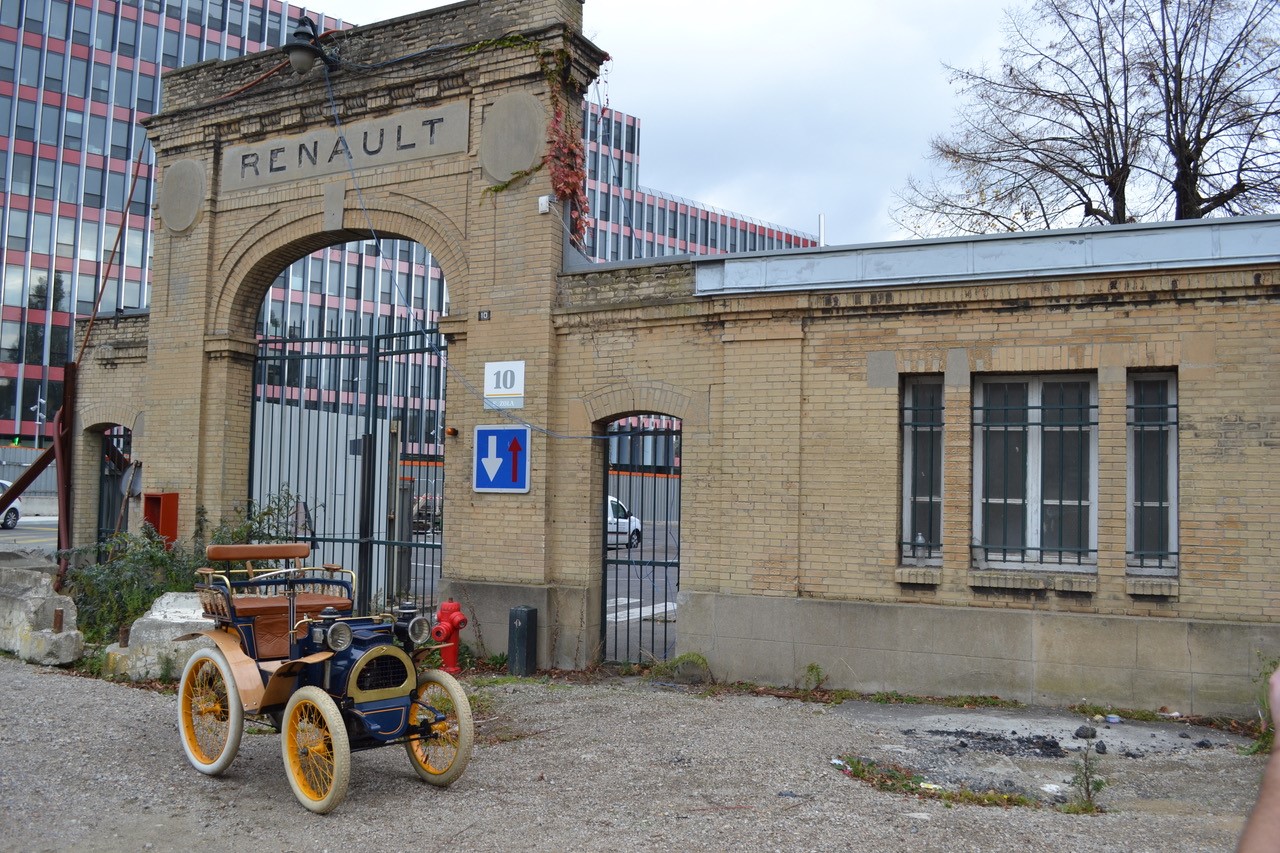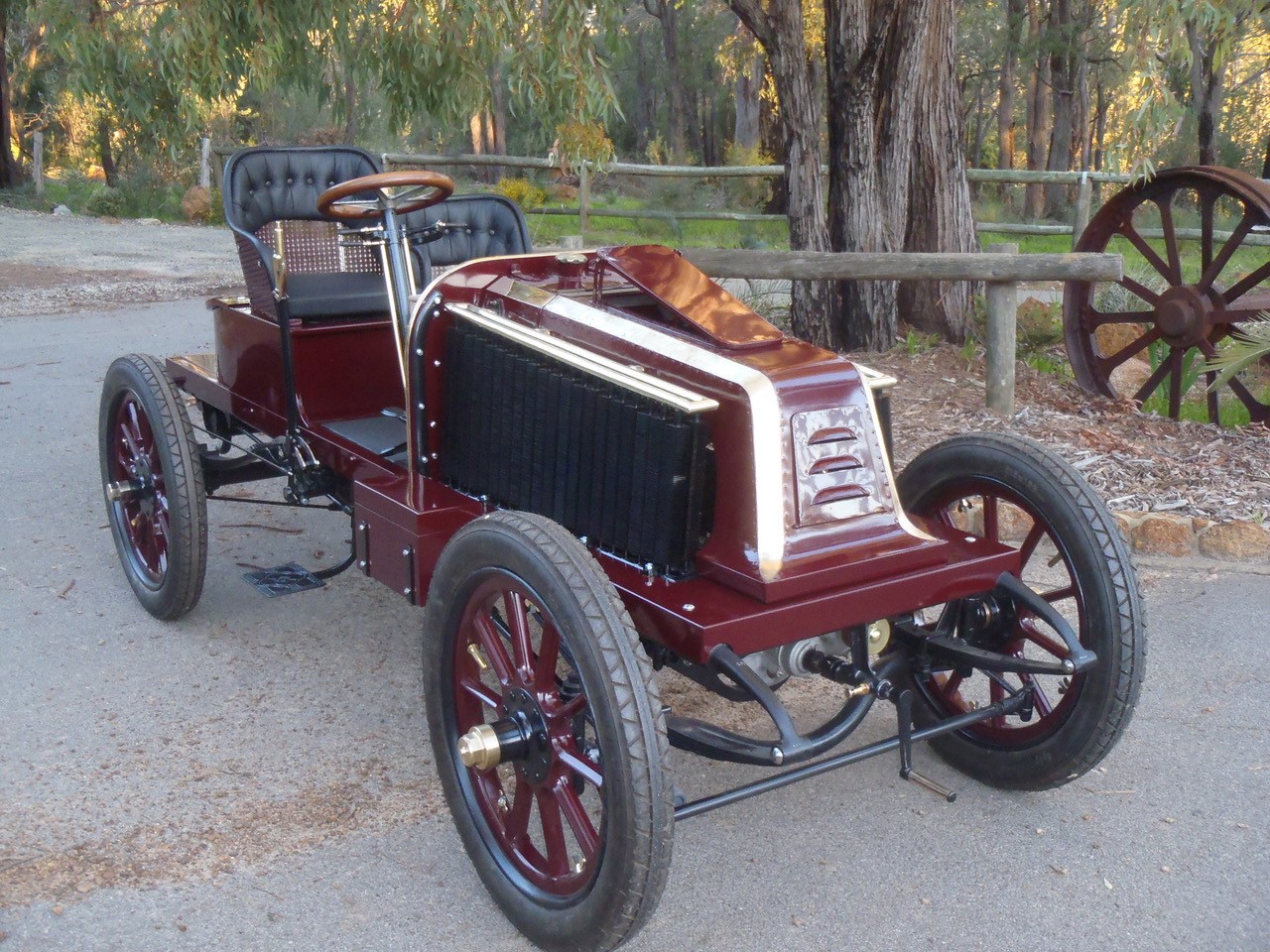By John Waterhouse
Perth, the capital city of the state of Western Australia, seems an unlikely location for two very early examples of Renault production cars. Nonetheless, it is the home for a 1899-1900 production version of Louis Renault’s first car, the single-cylinder, De Dion-Bouton-powered Type A, and a 1903 Type N, a car that used Renault’s first four-cylinder engine. 1
The Type A was the first Renault car, a ‘voiturette’ and pioneered the mechanical layout of engine-clutch-gearbox-driveshaft-differential-back axle. No chain drive for Renault! The car has a single-cylinder, air-cooled De Dion-Bouton engine and is capable of about 28 kph on the level with two people onboard. The development of this car (and others) was greatly facilitated by the successful engine design and production facilities of De Dion-Bouton in Paris.
The Type N that followed was a huge step forward in only three years from the early Type A car. In the intervening years, the Type B and Type C cars were made, both similar to the Type A. The Type B was a fully enclosed version of the Type A, perhaps the world’s first saloon car (although it more resembles a cupboard on wheels). The Type C was a development of the Type A with a more powerful, water-cooled engine with side-mounted radiators. Subsequent Renault ‘voiturette’ models in the early 1900s were also based on the Type A, all with De Dion-Bouton engines.
The story of Perth’s Renault Type A Renault 4 is that it was purchased from a museum in France by its current owner, Mr Peter Briggs, and displayed for some years at his York Motor Museum, some 100 km east of Perth. It was part of a diverse and interesting collection of cars that ranged, among many other vehicles, from a large, pre-war Adler though a 1952 Tatraplan to one of Piero Taruffi’s twin-boom specials. After some time, the Type A car was restored by a small team in Perth, led by Mr Lindsay Taylor, and supported from France very effectively by M. Bernard Dumas, a retired Renault executive. M. Dumas has some very interesting classic French cars, including a Type C Renault.
The subsequent Type N Renault was the result of a great step forward for Renault Freres. Whilst not large by the standards of some of the more established marques of the day, it is much larger than the early ‘voiturettes’ and it used a Renault engine. By 1902, Renault had developed its first engine, a 4-cylinder, water-cooled unit of 3.8 liter capacity 6 with two cylinder-blocks bolted to a common crankcase. In the Type K cars, the engine was used successfully in the famous intercity racing of the first years of the 20th century. Louis Renault’s brother Marcel had a surprise and emphatic win with this car against much larger vehicles in the first intercity race, from Paris to Vienna in 1902. He averaged a remarkable 63 km/hour over the 15 hours and 47 minutes he took to reach Vienna. Unfortunatley, Marcel Renault was killed in the 1903 Paris-Madrid race and Renault withdrew from those competitions.
The Type N car in Perth has similar engine but of smaller displacement than the Type K cars, some 2.5 liters, but otherwise it is understood to be very similar. Like the Type C car, the radiators run down the sides of the car ahead of the driver, and similar to the original Type A car, it also has what became the most conventional drive train for automobiles for many decades. Again, no chains for Louis Renault.
After 70 years off the road 8, the car was restored in 2015 for a local businessman, Mr Alan Tribe, by Mr Keith Cochrane. It had been discovered earlier, in 1968, in a Perth suburb, stripped of brasswork and body, sitting in an upturned water tank. At that time, it was purchased for £5 (US $7 at 2020 exchange rates) by a local body-shop owner. Although the car had a 4-seat body when new, it has been restored superbly in the style of a Paris-Vienna car.
The presence of a 1903 Type N Renault in Australia was a product of Renault’s early attention to export markets 10 and, probably, as a consequence of Renault becoming known because of the success in the Paris-Vienna race. The car is understood both to be one of 355 examples made for the British market and to be the first Renault imported to Western Australia.
It has an important part in the story of one of Western Australia’s most active motoring pioneers, Mr Claude Deane 11 . He imported the 1903 Type N Renault for sale locally to a mining magnate, Zebina Lane. Although the importation date is not known, the car was used to escort the Governor-General of Australia in Perth in 1905. It was used in the inland “Goldfields” area for many years, driven over tracks that would tax modern vehicles. One description of a road to the Goldfields is worth a mention:
“For the first 25 miles the road is fair, but after this is practically nothing but sand patch after sand patch, roots, stumps and water-courses – through to the first rabbit-proof fence at Youndegin, where water can be had, right on to where the telegraph line crosses the Kalgoorlie railway line, about two miles from Kellerberrin.” 12
Clearly, conditions were difficult to say the least. Add heat and flies to that description.
In 1907 the Renault was used for a planned reconnaissance of 354 km of the so-called “rabbit-proof fence”, constructed in the vain hope of stopping the westward migration of devastating plagues of European rabbits. The fence had been built using camels for material haulage, avoided towns, and presumably had no more than a rough and narrow track on either side. No support or supplies could be expected along most of its length. The attempt failed, it seems largely due to driver error causing damage to the vehicle, as the reports of the time suggested the car was quite capable of the trip. Subsequently it was reported travelling to other remote, gold-mining towns such as Cue and Sandstone. Some roads in this area have only been completed with bitumen sealing in recent years, no less than one century after the Renault traveled the area on bush tracks!
The Type N is an extremely interesting veteran car, not least given that its entire history is in Western Australia. There seems little doubt that Western Australia’s first Renault was one of the earliest examples of a motor vehicle venturing into the remote Australian bush where various gold mines had been developed. Its survival and restoration have added notably to Australia’s motoring heritage.
As a footnote, Renault’s next ‘voiturette’ after the Type A series cars was the 4CV of 1947-1961, a design that responded to expectations of austerity after World War 2. That 4CV design proved very successful and was the key to the company’s survival after the war, becoming the first French car to exceed production of 1 million units. The 4CV also set Renault up to great successes in the following decades, its rear transaxle allowing a smooth transition to modern, front-wheel drive models from the early 1960s.
John Waterhouse is an Australian French car enthusiast of many years standing. He is National Coordinator of the Renault 4CV Register of Australia. He is pleased to acknowledge the assistance and approval for use of photographs, both provided by Mr Graeme Cocks and for information from his books, one about the Type A car and the other on motoring pioneer Claude Deane, who imported the Type N to Western Australia. Both books are available through www.motoringpast.com.au.
It would be remiss not to acknowledge the superb efforts of the two restoration teams who have brought to life two remarkable historic Renaults for Australian enthusiasts to enjoy. The two owners’ financial support and enthusiasm for the projects equally deserve our thanks.
1 Jacques Borgé and Nicolas Viasnoff, 1977. Renault – l’Empire de Billancourt. e.p.a, Paris
2 Author’s photograph, Lindsay Taylor, the restorer, at the wheel.
3 Author’s photograph
4 Graeme Cocks, 2019: Louis Renault’s Amazing Type A. Motoring Past Vintage Publishing, Perth, Australia
5 Author’s photograph
6 Jacques Borgé and Nicolas Viasnoff, 1977. Renault – l’Empire de Billancourt. e.p.a, Paris
7 Photograph courtesy of Mr Graeme Cocks
8 Graeme Cocks, 2019: Claude Deane – Western Australia’s Motor Dealer Extraordinaire. Motoring Past Vintage Publishing, Perth, Australia
9 Graeme Cocks photograph
10 James M. Laux, 1976: In First Gear (The French Automobile Industry to 1914). Liverpool University Press, England
11 Graeme Cocks, 2019: Claude Deane – Western Australia’s Motor Dealer Extraordinaire. Motoring Past Vintage Publishing, Perth, Australia
12 Graeme Cocks, 2019: Claude Deane – Western Australia’s Motor Dealer Extraordinaire. Motoring Past Vintage Publishing, Perth, Australia
13 Colorised photograph provided by Mr Graeme Cocks
14 Photograph courtesy of Mr Graeme Cocks
15 Photograph courtesy of Mr Graeme Cocks









My Renault is turning 53 this year and still provides wonderful drives to its owner! Renault has been making cars since 1898!
Each one with a unique Gallic charm and strong reliability.
To see early Renaults in Australia shows they were rugged and able to withstand Australian weather!